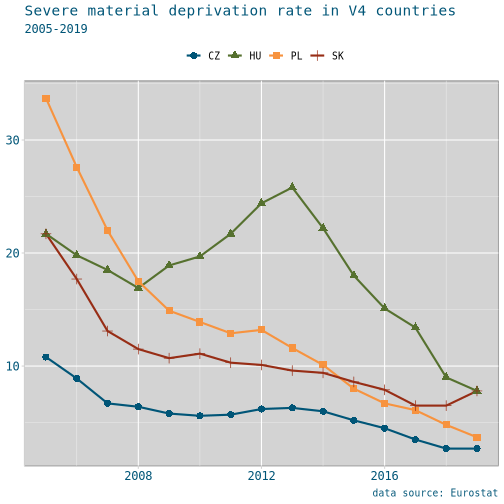Severe material deprivation rate (SMDR) in V4 countries, 2005-2019
With the exception of Hungary severe material deprivation rate (SMDR) declined unanimously in V4 countries after the EU accession. Hungary was hit harder by the social outcomes of 2008 financial crisis than Czechia, Poland or Slovakia. SMDR grew from 17 percent in 2008 to 26 percent point in 2013. However, the austerity measures of social-liberal government and unorthodox economic policy of the second Orbán cabinet resulted in a decline of SMDR after 2013 in Hungary. However, Poland was a real “fairy tale”1 among V4s in reducing SMDR to one tenth of its 2005 value.
The following plots on SMDR were made with R using eurostat and tidyverse packages with my ricing.
library(tidyverse)
library(eurostat)
# devtools::install_github("zgfabian/kimberlite")
library(kimberlite)
df <- get_eurostat("ilc_mddd12", time_format = "num")
v4 <- c("CZ", "HU", "PL", "SK")
df1 <- df %>%
filter(time >= 2005 & wstatus == "POP" &
age == "Y_GE18" & geo %in% v4 &
sex == "T")
p1 <- df1 %>%
ggplot(aes(time, values, color = geo, shape = geo)) +
geom_line(size = 1) +
geom_point(size = 3) +
labs(title = "Severe material deprivation rate in V4 countries",
subtitle = "2005-2019",
caption = "data source: Eurostat") +
scale_color_kimberlite() +
theme_kimberlite() +
theme(axis.title = element_blank(), legend.title = element_blank())
p1

Table: SMDR between 2005-2019
| time | CZ | HU | PL | SK |
|---|---|---|---|---|
| 2005 | 10.8 | 21.7 | 33.7 | 21.7 |
| 2006 | 8.9 | 19.8 | 27.6 | 17.7 |
| 2007 | 6.7 | 18.5 | 22.0 | 13.1 |
| 2008 | 6.4 | 16.9 | 17.5 | 11.5 |
| 2009 | 5.8 | 18.9 | 14.9 | 10.7 |
| 2010 | 5.6 | 19.7 | 13.9 | 11.1 |
| 2011 | 5.7 | 21.7 | 12.9 | 10.3 |
| 2012 | 6.2 | 24.4 | 13.2 | 10.1 |
| 2013 | 6.3 | 25.8 | 11.6 | 9.6 |
| 2014 | 6.0 | 22.2 | 10.1 | 9.4 |
| 2015 | 5.2 | 18.0 | 8.0 | 8.6 |
| 2016 | 4.5 | 15.1 | 6.7 | 7.9 |
| 2017 | 3.5 | 13.4 | 6.1 | 6.5 |
| 2018 | 2.7 | 9.0 | 4.8 | 6.5 |
| 2019 | 2.7 | 7.8 | 3.7 | 7.8 |
material deprivation rate is the percentage of the population that cannot afford at least three of the following nine items: (1) to pay their rent, mortgage or utility bills; (2) to keep their home adequately warm; (3) to face unexpected expenses; (4) to eat meat or proteins regularly; (5) to go on holiday; (6) a television set; (7) a washing machine; (8) a car; (9) a telephone. Severe material deprivation rate is defined as the enforced inability to pay for at least four of the above-mentioned items. Source: EUROSTAT glossary
- Browse Eurostat database
- Browse
ilc_mddd12in the EUROSTAT Data Explorer - Browse
ilc_mddd12in the EUROSTAT: Data Browser
Tutorial for the eurostat R package
-
To paraphrase György Matolcsy, president of the National Bank of Hungary who gave an interview to CNN in 2012. He used this term for Hungary’s economic prospects. ↩

